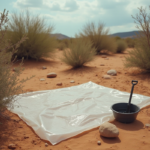When it comes to survival or simply thriving in the great outdoors, knowing how to use pine charcoal to purify water is an invaluable skill. It’s simple, effective, and a resourceful way to ensure you have clean drinking water even when you’re miles away from civilization.
Why Pine Charcoal?
Pine charcoal is excellent for water purification due to its porous nature. It works by trapping impurities, filtering out harmful particles, and even improving water’s taste. Pine trees are widespread, making this method accessible in most forested areas.
Step-by-Step Guide to Purifying Water
1. Gather Your Materials
To get started, you’ll need:
- Pine branches to create charcoal
- A fire source
- A container or makeshift filter (like a plastic bottle)
- Sand, pebbles, and cloth
Start by making a campfire. Burn the pine branches until they turn into a blackened, brittle substance. That’s your charcoal! Let it cool completely before handling.
2. Build Your Water Filter
Creating a DIY water filter is straightforward. If you have an empty bottle:
- Cut off the bottom to create a funnel.
- Layer the inside with cloth, pine charcoal, sand, and pebbles. Each layer plays a role—charcoal absorbs toxins, sand catches small debris, and pebbles stop large particles.
If you don’t have a bottle, improvise with bark or fabric to hold your layers in place.
3. Filter the Water
Pour the collected water slowly through the filter. Allow the water to seep through each layer, leaving behind impurities.
4. Test and Boil
While pine charcoal removes most contaminants, it’s a good practice to boil the water after filtering. This ensures any lingering bacteria or pathogens are eliminated.
Benefits of Using Pine Charcoal
- Natural and Accessible: Pine is easy to find in many environments.
- Affordable: This method costs nothing but your effort and time.
- Eco-Friendly: It uses natural resources without leaving a lasting impact on the environment.
Tips for Success
Know Your Environment
Before setting out, research if pine trees are common in your area. If not, learn about other types of wood suitable for making charcoal.
Carry Backup Supplies
A small piece of fabric, a lightweight container, or even a portable filter kit can make the process smoother.
Stay Hygienic
Handling raw materials can introduce contaminants. Wash your hands or use gloves when preparing your filter.
The Science Behind Pine Charcoal
Activated carbon, which is essentially a more refined version of charcoal, is widely used in industrial water filters. Pine charcoal operates on the same principles but in a natural and basic form. The microscopic pores in the charcoal act as traps, holding on to impurities as water passes through.
Pine Charcoal in Urban Settings
This technique isn’t just for wilderness survival. In emergencies like natural disasters, when clean water might not be readily available, creating a charcoal filter can be a lifesaver. Keep this skill in your prepping arsenal—it might come in handy when you least expect it!
Mastering how to purify water using pine charcoal is empowering. It connects you to the environment and equips you with a skill that could save lives. Next time you’re out in nature, practice this method—it’s not just practical, it’s also deeply satisfying.



